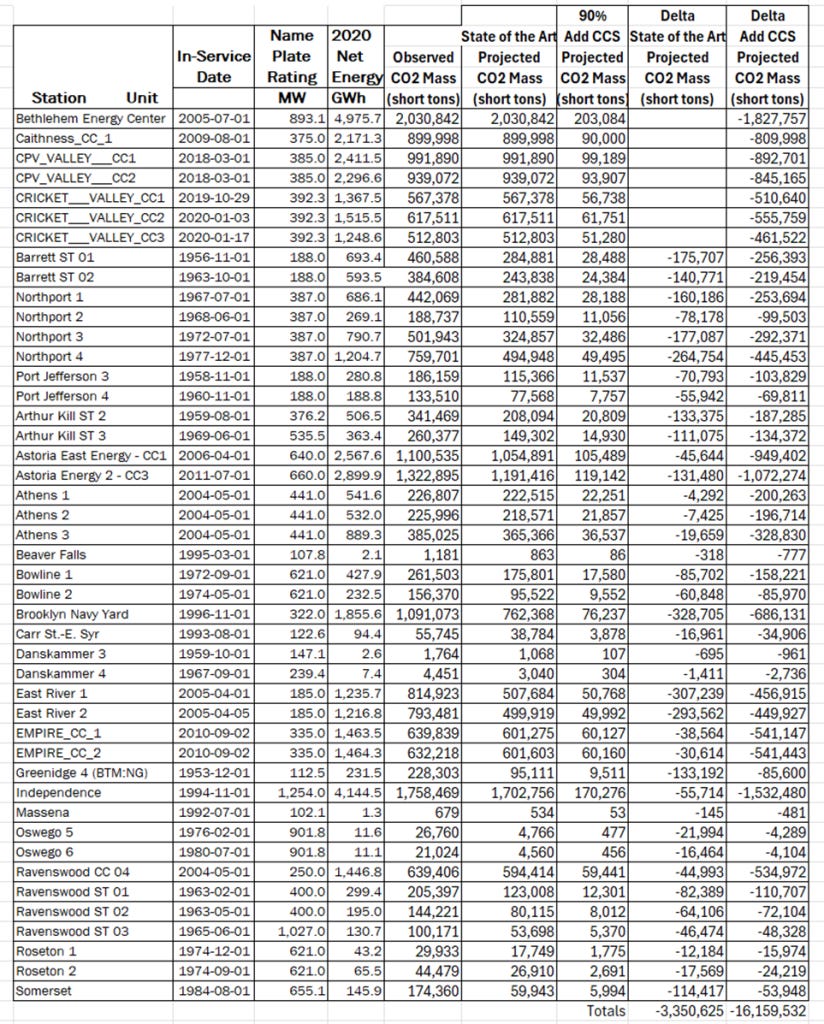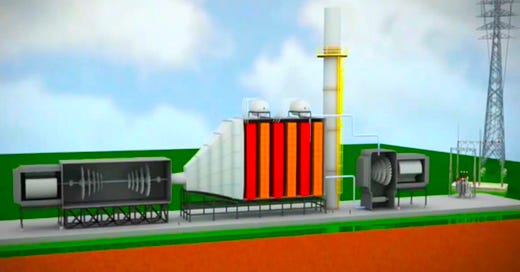New York Needs Combined Cycle Natural Gas and Nuclear Plants to Ensure Energy Security. There's No Avoiding It.
Guest Post by Roger Caiazza of Pragmatic Environmentalist of New York.
On March 18, 2025 Senator Mattera invited Richard Ellenbogen to Albany to address the NY State Senate Energy & Telecommunications Committee regarding NY State’s energy situation relative to the Climate Leadership & Community Protection Act (Climate Act). I was impressed the meeting showed the Committee agreed with Ellenbogen that there are implementation issues and course corrections are necessary. This post describes the emission estimates I provided and puts electric generating unit emissions in context.
Senate Energy and Telecommunications Committee Meeting
On March 18, 2025 Senator Mattera invited Richard Ellenbogen to Albany to address the NY State Senate Energy & Telecommunications Committeeregarding NY State’s energy situation. Senator Parker, the committee chair, gave Ellenbogen time to describe his thoughts on the Climate Act transition, describe his proposal to use existing technology that will not get to zero but will maintain system reliability, and answer questions. There is a video of the hearing available and my previous post includes links to specific discussions within the video.
Ellenbogen’s presentation argued that there is a better way that “adheres to reality”. He believes repowering existing power plants with combined cycle gas turbines gives a carbon reduction of “30 to 40%.” Replacing the old units reduces emissions, decreases reliability risks because the old units are so old that they are more likely to fail, and because the combined cycle plants are more efficient, they would burn less fuel to produce the same amount of electricity.
During the discussions at the meeting, Chairman Parker said a couple of times that he wanted to get specific numbers for potential emission reductions. In my description of the meeting, I promised to publish a post describing my supplemental emissions analysis that provided those numbers. This article fulfills that promise.
Observed and Projected Electric Generating Unit Emissions Analysis
Following the meeting I sent Ellenbogen material to send on to Senator Parker. The evaluation of observed electric generating unit carbon dioxide (CO2) emissions for selected New York power plants that represent the current state-of-the-art compared with other existing units included the information requested.
My submittal included a detailed description of the analysis as well as the spreadsheet that generated the data in each table in the report. The description includes references to each tab within the spreadsheet that provides the data for every table. I am only going to summarize the evaluation because the documentation provides the details.
The analysis was complicated because it was necessary to combine two different data sets for the comparison. I used the EPA Clean Air Markets Division data that includes CO2, SO2, and NOx emissions along with several operating parameters. Unfortunately, the EPA load data represents gross load and net loads are needed to project CO2 emissions for the different scenarios.
The New York Independent System Operator (NYISO) annual load and capacity data report, universally known as the “Gold Book, provides net loads. I chose 2020 because I wanted to include the Somerset coal-fired power plant information to represent the highest CO2 emissions.
Because of naming convention and facility component differences, it was not possible to include all the steam turbine, combined cycle or cogeneration units in the state. However, the 43 units (Note the report refers to 45 units but there are only 43 units in the tables) included provide a representative sample of the state, representative data for state-of-the-art generating units, and includes specific units that were requested by the Committee.
I manually combined 2020 data from the two data sets for 43 electric generating units as shown in Table 3 from the report (NY Emissions Analysis.xls “Compare 2020” tab). It combines the NYISO net energy (GWh) and the EPA CO2 emissions (tons) to determine the state-of-the-art CO2 emission rate (tons/GWh). Note that the CO2 emission rate ranges from just over 400 for the combined cycle gas turbines to 1200 tons per GWh for a coal plant.
I assumed that the new Cricket Valley, CPV-Valley, and Caithness combined cycle gas turbines represent a state-of-the art combined cycle power plant. Table 3 below (click to enlarge) shows that those three facilities do represent the lowest emission rates and that the Bethlehem Energy Center is within their ranges so also state-of-the-art. I assumed that the average of the blue highlighted cells represents a representative state-of-the-art combined cycle power plant CO2 emission rate (410.8 tons CO2 per GWh).

Table 4 (NY Emissions Analysis.xls “2020 Projections” tab) compares existing emissions to estimated emissions if the facility were replaced with a state-of-the art combined cycle combined cycle gas turbine power plant with and without a carbon capture and sequestration (CCS) control equipment. The observed CO2 Mass column lists 2020 annual emissions.
The state-of-the-art projected CO2 emissions column equals the state-of-the-art combined cycle power plant CO2 emission rate (410.8 tons CO2 per GWh times the observed 2020 net energy rate. The column that adds the CCS control at 90% efficiency lists the emissions if the control equipment were in place. There are also columns that list the difference between observed emissions and these projections.

In 2020 the electric sector emitted 26,920,636 tons of CO2. The 45 units included in this analysis emitted 21,305,661 tons representing 79% of the total. If all 45 units were state-of-the-art combined cycle natural gas fired combustion turbines, the emissions would be reduced to 17,955,036 tons which is a 16% reduction.
If all 45 units added carbon capture and sequestration control equipment, the emissions would be reduced to 1,795,504 tons, a 76% reduction. My results are less than the Ellenbogen presentation because I did not account for the improved efficiency and resulting lower fuel use that would reduce emissions more.
Future Electric System
I also projected 2040 CO2 emissions for a pragmatic future electric system that relies on nuclear power but uses state-of-the-art combined cycle natural gas fired combustion turbines (CCGT) for peaking support.
Making projections for future electric energy sector resource allocations is best left to the professional electric system planners who can use complex and sophisticated models that can incorporate the nuances of the capabilities and performance of different types of generation.
The biggest problem is that an electric system that relies on wind and solar resources needs to overbuild wind and solar capacity. This introduces a significant error in my projection approach. Nonetheless, this analysis gives a rough idea of potential emissions for two scenarios – building CCGT instead of renewables and building nuclear for everything except peaking generation.
The detailed description of the analysis provides specifics. In brief, I first chose a New York Independent System Operator (NYISO) annual energy forecast for the emissions projection. The second step was to allocate the generation needed to provide the NYISO future energy projection. I made many assumptions to establish the arbitrary generation resource categories I used in my projections.
I considered two future scenarios for 2040. In Scenario 1 the existing nuclear and hydro capacity and generation stay the same but new combined cycle gas turbines provide all the capacity and generation necessary to meet the NYISO forecast. In Scenario 2 the existing hydro capacity and generation stayed the same, new combined cycle gas turbines provide the peaking power and all the remaining capacity and generation necessary is provided by nuclear power.
My results showed significant reductions are possible with these scenarios.
If nuclear and hydro stay the same and new CCGT is used to make up the capacity and energy necessary to match the NYISO forecast, then the emission projection is 70,301,856 tons of CO2 or 7,030,186 tons with 90% CCS controls. This is an overestimate because the NYISO projection incorporates over-building wind and solar capacity that would not be necessary if conventional generating resources are used.
The second scenario in which nuclear is used for everything except peaking generation and CCGT is only used for peaking purposes is probably closer to a realistic estimate. That scenario predicts that using fossil fuels solely for that purpose would produce 1,226,718 tons of CO2 and only 122,672 tons if 90% CCS was employed. This also is an over-estimate because of the renewable over-building but the significantly lower emissions shows how effective nuclear power is for reducing emissions.
Relative Impacts
The nuclear/CCGT approach does not eliminate 100% of CO2 emissions. However, New York GHG emissions are less than one half of one percent of global emissions and global emissions have been increasing on average by more than one half of one percent per year since 1990. Even Senator Parker acknowledges that this means “at the end of the day New York is not going to solve the climate crisis”.
There is one other argument in favor of this pragmatic approach. In short, New York’s impact on global warming is unmeasurable. Table 9 (NY Emissions Analysis.xls “Warming Averted” tab) projects the amount of global warming “savings” for the projection scenarios and historical emissions. The calculations are based on a Perplexity AI query “What is the expected change in global warming per ton of CO2 reduced”. None of the emission scenarios for the projected warming predict measurable changes in global warming.
Conclusion
The purpose of this analysis is to show a state-of-the-art combined cycle natural gas-fired turbine is so efficient it has significantly lower CO2 emissions than existing fossil-fired units in New York.
If a cost-effective carbon capture and sequestration system could be added to those facilities the emissions are reduced much more. When combined with nuclear power for baseload electric power, there are advantages to using a system with combined cycle gas turbines when compared to using a system based on using wind, solar, and energy storage.
The energy density of wind and solar energy is so low and the resource intermittency so variable hat no electric system relying on those resources for most of its energy can ever hope to provide reliable electricity. The low energy density requires a massive buildout of transmission, and an intermittent weather-dependent system requires an unproven dispatchable emissions-free resource.
The nuclear/CCGT approach resolves those challenges. When the potential effects of New York emissions on global warming are considered, it is apparent that zero emissions mandates do not provide any measurable benefits.
The negligible relative impacts of New York emissions does not mean we should do nothing, but it does suggest that strategies that do not go to zero should not be rejected.
This is especially true if those strategies can be implemented for a fraction of the cost of the current plan. In addition, the emissions from combined cycle gas turbines used to replace existing generation would not meaningfully contribute to global warming but their continued use not only reduces emissions over historical levels but also resolves reliability challenges that must be addressed if zero emissions are mandated. The concept of natural gas as a bridge fuel for even lower-emission alternatives is a pragmatic approach.
#Caiazza #Climate #CombinedCycle #NewYork #NaturalGas #Nuclear #Emissions
Roger Caiazza blogs on New York energy and environmental issues at Pragmatic Environmentalist of New York. This post represents his opinion alone and not the opinion of his previous employers or any other company with which he has been associated. Roger has followed the Climate Leadership & Community Protection Act (Climate Act) since it was first proposed, submitted comments on the Climate Act implementation plan, and has written over 490 articles about New York’s net-zero transition.





